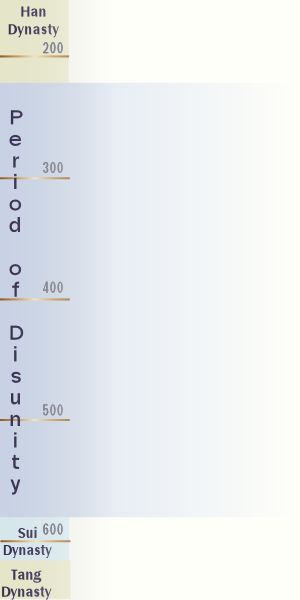China disunited 220 - 589

After the fall of the Han dynasty China broke apart. From 220CE until 589CE it is a tale of kingdoms and short lived dynasties that never brought China under unified rule. The disunity and warfare brought little in the way of development, indeed China looked back to the Han and Zhou dynasties with nostalgia as China’s ‘golden age’. It has been called the time of the Six Dynasties, but that over-simplifies the situation. It is usually split into two periods, a short 45 year ‘Three Kingdoms’ period followed by the main ‘Period of Disunity’.
It was at this time that Buddhism came to China from India along the Silk Road. In 399 a monk, Fa Xian ➚ set out from Chang'an and traveled over the mountains to Buddha's birthplace in Nepal. He then visited Sri Lanka in an epic 14 year journey. His journey was repeated on a grander scale by Xuanzang 230 years later. Always strongest in the south and west of China, Buddhism has had a deep influence on China's rulers and guiding philosophy. China adopted the milder Mahayana form of Buddhism. The religion acted as a counterbalance to the prevailing Confucian philosophy. At the same time the Daoist tradition reacted to the new religion by re-invigorating its belief system.
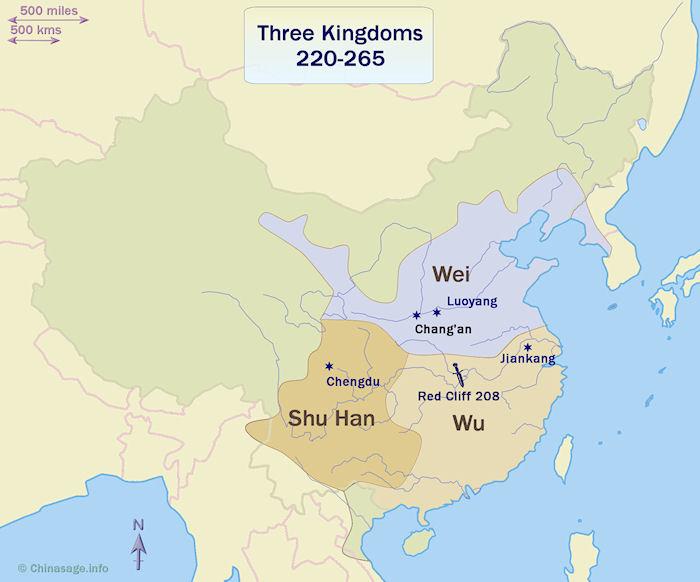
Three Kingdoms (220-265)
The Yellow Turbans (or Scarves) Rebellion had Daoist roots; they followed the (太平道 tài píng dào) - ‘Way of Supreme Peace’, to be echoed by the Taiping Rebellion 1,700 years later. The rebellion started in Hebei in 184CE and was fueled by desperation over famine and disease. The leader Zhang Jue ➚ drew support after offering a magic potion that claimed to cure a disease that was causing an epidemic. It was the first well-organized peasant rebellion against Imperial rule and took 20 years to defeat. The mobilization of armies to suppress the revolt destabilized central control and the Han dynasty came to a disorganized collapse. Han power had become weakened by power struggles between the Empress's family; eunuchs and officials. The eunuchs controlled access to the Emperor and became corrupt, putting forward their own family and associates for highly paid appointments. The Emperor became a prisoner in his own palace, cut off from the real world.
The Han Empire then split into Three Kingdoms (Wei (north); Wu (south) and Shu Han (west)). The cultural legacy lives on in the very famous romantic novel ‘Romance of the Three Kingdoms’ by Luo Guanzhong; the book was a remarkable achievement for its time. The most important of the three kingdoms, the northern Wei kingdom was founded by Cao Cao ➚ (155-220) and his son Cao Pi (Wen Wendi) (220-226). The decisive battle was at Red Cliffs (赤壁之战) in 208CE when the northern forces under Cao Cao met a southern army at Wulin on the Yangzi River just upstream from Wuhan, Hubei. The epic film 'Red Cliff ➚' dramatizes the conflict and particularly the influence of the skilled adviser Zhuge Liang. The southern forces led by Sun Quan ➚ won the battle and Cao Cao's dream of rebuilding a united nation foundered. The warlord Liu Bei broke off western China to form the Shu kingdom (centered on Sichuan) while Sun Quan took Southern China to form the Wu kingdom (centered around the Yangzi valley). These two new kingdoms represented the emergence of new centers of Han civilization away from the Yellow River heartland. Battles were fought with immense vigor and cruelty, with often the mass slaughter of civilians in captured cities. Many fled, taking memories of the happier times of the Han dynasty with them. Even though the areas in the south and west of China had already considerable numbers of indigenous people, many Han Chinese fled famine and war in the north to begin new lives amongst them.
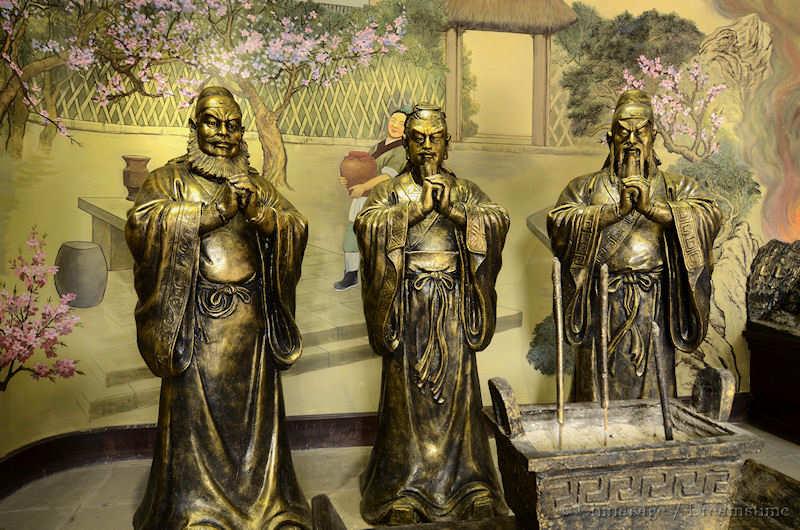
Cao Cao 曹操 [155 - 15 Mar 220] or Ts'ao Ts'ao WG

By Wang Qi (1529 - 1612) available under a Creative Commons license ➚.
The actions of Cao Cao brought about the end of the Han dynasty. He was the adopted son (or maybe grandson) of a senior eunuch at court and took military control of northern China. Cao was initially considered loyal and incorruptible being given the illustrious grade of Xiaolian ➚ 孝廉. He built a loyal strong army from remnants of the Yellow Turban rebels that he defeated.
At the Battle of Guandu ➚ (200CE) his army defeated another warlord, Yuan Shao, and then he reinforced his grip on northern China seeking to restore power to the beleaguered Han dynasty. Cao's daughter was married to the last Han Emperor Xiandi, greatly enhancing his influence. His defeat at the Battle of Red Cliffs (赤壁之战 chì bì zhī zhàn) ended these ambitions. On Cao Cao's death his son Cao Pi proclaimed himself founder of a new ‘Wei dynasty’ of northern China.
This period is made famous by the book ‘The Romance of the Three Kingdoms’ and because of that is one of the most widely known periods of Chinese history. In the book Cao Cao is unfairly portrayed as an evil tyrant and villain. He was perceived to have acted without the Mandate of Heaven to achieve his selfish ways. He is often featured as the villain in traditional operas with white make-up to emphasize his treachery. His actions were considered devious and Machiavellian ➚. A famous story says something more nuanced of his character. When approaching a field of ripe wheat he forbade anyone under threat of death from damaging or harvesting the crop. However his own horse took fright and trampled the field. Keen to stick to his word he punished himself by cutting off his own hair.
Proverbial Badness
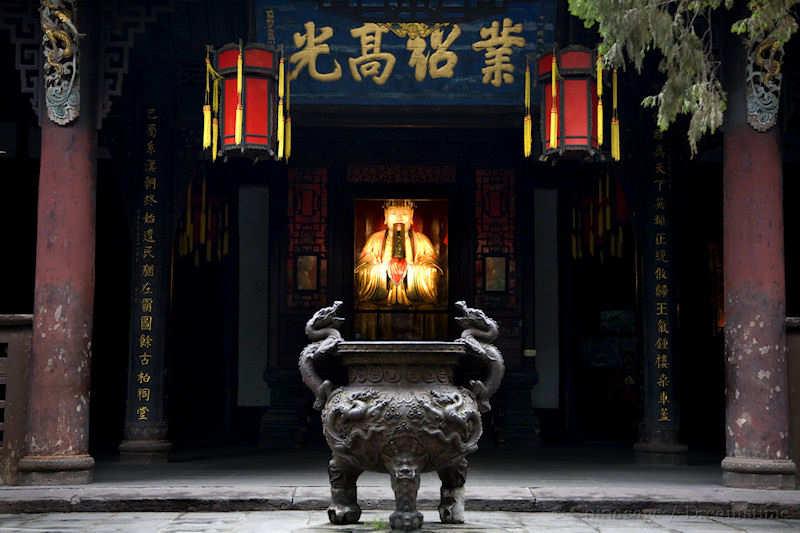
Period of Disunity (265-589)
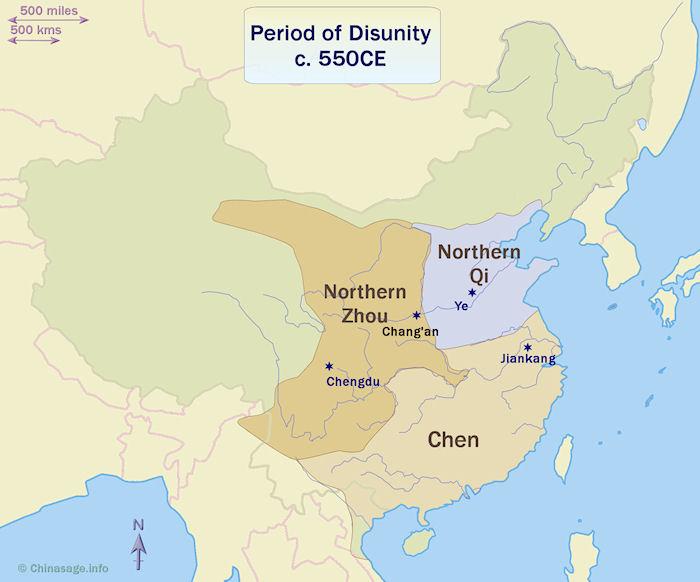
The map shows rough territories of the rival kingdoms later on in the Period of Disunity.
When the Three Kingdoms period ended, China entered the ‘Period of Disunity’ when many doomed dynasties were founded to only rapidly collapse. They were in the south: Western Jin; Eastern Jin; Liu Song; Qi; Liang and Chen, and in the north the Sixteen Kingdoms: Northern Wei; East and West Wei; Northern Qi and Northern Zhou. It was a complex patchwork of powerful families and tribes seizing power in a small region for a brief spell. Each establish a ruling family elite from which others were excluded. Central power was weak and justice arbitrary.
Meanwhile ordinary people struggled on despite the lack of strong governance in the Period of Disunity. The use of paper became more widespread; the humble wheelbarrow was widely used (the Chinese version has the wheel in the middle not the front); advances in water management and bridge engineering took place. Wider contact with neighboring countries brought in new foods: bananas, walnuts and pomegranates. The arts flourished and traditional medicine was made more systematic. The esteemed master of calligraphy Wang Xizhi (321-379) lived during this period. The high level of general cultural development is evident from the compilation of the first encyclopedia comprising up to 8 million characters.

A Chinese Dark Age?
During the Period of Disunity, the Wei conquered the Shu kingdom in 265 and the Western Jin dynasty was founded. This was a dynasty built on family patronage and led to revolts between the leading families. The weakness of the state was exploited by tribes to the north. Liu Yuan of the Xiongnu tribe ➚ led a revolt and brought the Western Jin to an end. The north then broke into small kingdoms and fiefdoms of which 16 are significant and so is called the ‘Sixteen Kingdoms’. The northern Tuoba tribe part of the Xianbei ➚ formed the Northern Wei dynasty in 386. The Northern Wei (386-534) split into Eastern (534-550) and Western Wei (535-557) and then Northern Qi (550-577) and Northern Zhou (557-581), these five are collectively referred as the ‘Northern Dynasties’. Although the term ‘dynasty’ is used, these short-lived epochs do not represent unified central control, they are just convenient labels for a period of time. The customs and traditions of these northern tribes were gradually assimilated into Chinese culture. Contact with the Roman (Da Qin) and Persian Empires continued in the westernmost kingdoms. Parallels are often drawn between this period and the ‘European Dark Ages ➚’ following the fall of Rome. In general, China suffered less trauma and the seeds of a second re-unification were already sown, Chinese language and culture were never swamped by invasions as they were in Europe. Gradual cultural development continued despite the lack of centralized administration.
Peaceful South
Meanwhile, in the south of China Sima Riyu founded the Eastern Jin dynasty in 317 with capital at Nanjing. Many people moved from northern China to settle in the Yangzi valley and lands further south to escape the turmoil in the north. The dynasties Liu Song; Qi (479-502); Liang (502-557) and Chen (557-589) form the 'Southern Dynasties' administered from Nanjing (then known as Jiankang). In the south, important trade routes by sea were opened as access to the Silk Route in northern China was closed to them. Buddhism found its way into China and together with Daoism began to replace the Confucian guiding philosophy. The period of disunity and turmoil led to an appreciation of the relative harmony under the preceding Zhou and Han dynasties, it reinforced the desire for the re-establishment of a unified 'Han' China. The re-unification finally came from the military efforts of the Northern Zhou kingdom and the Sui dynasty was founded.
